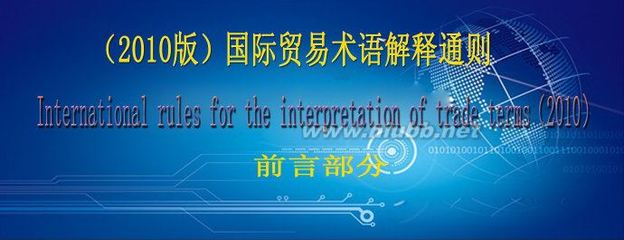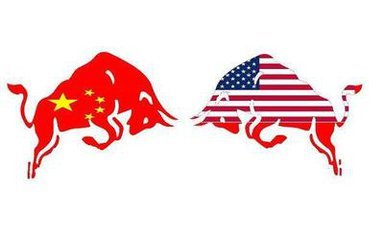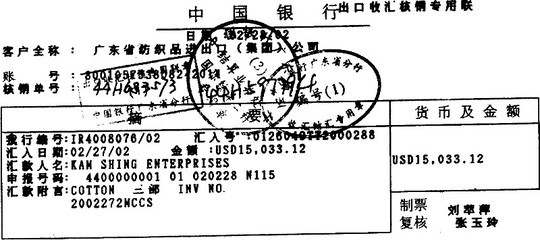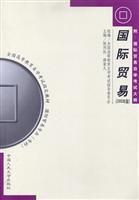
International rules for the interpretation oftrade terms(2010)
Foreword前言
By Rajat Gupta,ICC Chairman国际商会主席Rajat Gupta
The global economy has given business broader access thanever before to markets all over the world. Goods are sold in morecountries,in large quantities, and in greatervariety. But as the volume and complexity of global sales increase,so do possibilities for misunderstandings and costly disputes whensale contracts are not adequately drafted.
The Incoterms® rules, the ICC rules on the use of domesticand international trade terms, facilitate the conduct of globaltrade. Reference to an Icoterms 2010 rule in a sale contractclearly
defines the parties' respective obligation sand reduces therisk of legal complications.
全球经济一体化让生意的接触面比以往任何时候都宽广,可以触及世界每个角落。更多品种的货物可供选择、卖向更多国家、卖得也越来越多。然而,随着全球贸易数额的增加和贸易复杂性的加强,因贸易合同起草不恰当而带来的误解和高代价争端也可能随之增加。
国际贸易术语解释通则,国际商会规则在国内和国际贸易用语的使用促进了全球贸易的进行。在贸易合同中引用国际贸易术语解释通则2010可明确界定各方义务并降低法律纠纷产生的风险。
Since the creation of the Incoterms rules by ICC in 1936,this globally accepted contractual standard has been regularlyupdated to keep pace with the development of international trade.The Incoterms2010 rules take account of the continued spread ofcustoms-free zones, the increase of electronic communications inbusiness transactions, heightened concern about security in themovement of goods and consolidates in transport practices.Incoterms2010 updates and consolidates the 'delivered' rules,reducing the total number of rules from 13 to 11, and offers asimpler and clearer presentation of all the rules. Incoterms 2010is also the first version of the Incoterms rules to make allreferences to buyers and sellers gender-neutral.
The broad expertise of ICC's Commission on Commercial Lawand Practice, whose membership is drawn from all parts of the worldand all trade sectors, ensures that the Incoterms 2010 rulesrespond to business needs everywhere.
自从1936年国际商会制定出国际贸易术语解释通则之后,此项在全球范围内被采用的合同标准就经常性地更新换代,与国际贸易的发展步调一致。国际贸易术语解释通则2010考虑了免税贸易区的不断增加,电子沟通在商务中的不断增多,以及被更加重视的货物运输中的安全和变化等问题。国际贸易术语解释通则2010更新并加强了交货规则,将规则总量从13条减少到了11条,并且使得所有规则的表述更加简洁明确。国际贸易术语解释通则2010同时也是第一个使得所有在买卖双方中的适用保持中立的第一个国际贸易术语解释版本。
国际商会的商法和实践委员会成员来自世界各地和多个贸易部门,该委员会广泛的专业技能确保了国际贸易术语解释通则2010与各地的商贸需求相适应。
ICC would like to express its gratitude to the members ofthe Commission, chaired by Fabio Bortolotti (Italy), to theDrafting Group, which comprised Charles Debattista(Co-Chair,France), Jens Bredow(Germany), Johnny Herre(Sweden), DavidLwee(UK), Lauri Railas(Finland), Frank Reynolds(US),and MiroslavSubert(Szech Republic), and to Asko Raty (Finland)for assistancewith the images depicting the 11 rules.
国际商会向Fabio Bortolotti(意大利)的商法和实践委员会的成员表示谢意,向由Charles Debattista(副组长,英国),Christoph Martin Radtke(副组长,法国),Jens Bredow (德国),JohnnyHerre (瑞典),David Lwee(英国),Lauri Railas (芬兰),Frank Reynold(美国),Miroslav Subert (捷克)组成的起草小组致谢,并且向对11条规则的表述给予帮助的Asko Raty (芬兰)致谢。
INTRODUCTION介绍
The Incoterms® rules explain a set of three-letter tradeterms reflecting business-to-business practice in contracts for thesale of goods. The Incoterms® rules describe mainly the tasks,costs and risks involved in the delivery of goods from sellers tobuyers.
Incoterms®规则对一系列三个字母组成的贸易术语进行了解释,这些贸易术语对B2B的货物销售合同有着实际影响。Incoterms®规则主要描述了货物从卖方到买方运输过程中涉及的责任,费用和风险的划分。
How to use the Incoterms® 2010 rules如何适用Incoterms®2010规则
1. Incorporate the Incoterms® 2010 rules into your contractof sale If you want the Incoterms® 2010 rules to apply to yourcontract, you should make this clear in the contract, through suchwords as, “[the chosen Incoterms rule including the named place,followed by] Incoterms® 2010”.
1.在销售合同中明示应用Incoterms®2010规则,如果要使合同适用Incoterms规则2010,应在合同中明确表明,例如:所选择的Incoterms规则(含指定地点)适用Incoterms®规则2010。
2. Choose the appropriate Incoterms rule.选择最契合的Incoterms规则.
The chosen Incotermsrule needs to be appropriate to the goods, to the means of theirtransport, and above all to whether the parties intend to putadditional obligations, for example suchas the obligation to organize carriage or insurance, on the selleror on the buyer. The Guidance Note to each Incoterms rulecontains information that is particularly helpful when making thischoice. Whichever Incoterms rule is chosen, the parties should beaware the interpretation of their contract may well be influencedby customs particular to the port or place being used.
所选的Incoterms规需要契合实际,主要考虑因素有三点,1、货物,2、运输方式、3,买卖方是否要加入其它责任条款,例如将办理运输或保险的义务加于买方或卖方。每项通则条款的解释性说明,都对做出恰当的选择极有帮助。不论选用哪条Incoterms规则,双方应该意识到合同的解释会深深地受到惯例影响,尤其是提及的港口或地名。
3. Specify your place or port as precisely as possible.尽可能精准地描述你方地址或港口名称
The chosen Incoterms rule can work only if the parties namea place or port, and will work best if the parties specify theplace or port as precisely as possible.
A good example of such precision wouldbe::
“FCA 38 Cours Albert 1er, Paris, France Incoterms2010”.
Under the Incoterms rule Ex Works(EXW),Free Carrier(FCA),Delivered at Terminal(DAT), Delivered at Place(DAP),Delivered DutyPaid(DDP),
只有当事人双方选定特定的一个收货地或港口时,所选术语才能发挥作用。地点或港口名称越精准,Inconterms规则越有效。以下精准描述就是一个很好的例子:
Incoterms 2010,FCA规则,法国,巴黎,38Cours Albert 1er
在Incoterms规则下:
EXW 工厂交货(……指定地点)
FCA 货交承运人(……指定地点)”
DAT 终点站交货(……指定目的地)
DAP 地点交货 (……指定目的地)
DDP 完税后交货(……指定目的地)
Free Alongside Ship(FAS), and Free on Board(FOB),the namedplace is the place where delivery takes place and where risk passesfrom the seller to the buyer.
Under the Incoterms rule Carriage Paid to(CPT), Carriageand Insurance Paid to(CIP), Cost and Freight(CFR) and Cost,Insurance and Freight(CIF),the named place differs from the placeof delivery. Under these four Incoterms rules, the named place isthe place of destination to which carriage is paid.
Indications as to place or destination can helpfully befurther specified by stating a precise point in that place ordestination in order to avoid doubt or argument.
FAS 船边交货(……指定装运港)
FOB 船上交货(……指定装运港)
此处所指地点为交货地点,同时风险也从卖方转移至买方
Incoterms规则下
CPT 运费付至(……指定目的地)
CIP 运费、保险费付至(…指定目的地)
CFR 成本加运费(……指定目的港)
CIF 成本、保险费 加运费(指定目的港)
所指地点随交货地不同而不同。在这些Incoterms规则下,所指地点为运费付至地。
为了避免疑问和争议,指定地点或目的地可以进一步阐述为一个精确的地点。
4. Remember that Incoterms rules do not give you a completecontract of sale
Incoterms rules do say which party to the sale contract hasthe obligation to make carriage or insurance arrangements, when theseller delivers the goods to the buyer, and which costs each partyis responsible for.
谨记Incoterms规则并没有给当事人提供一份完整的销售合同
Incoterms rules, however, say nothing about the price to bepaid or the method of its payment. Neither do they deal with thetransfer of ownership of the goods, or the consequences of a breachof contract. These matters are normally dealt with through expressterms in the contract of sale or in the law governing thatcontract. The parties should be aware that mandatory local law mayoverride any aspect of the sale contract, including the chosenIncoterms rules.
Incoterms规则确有阐述销售合同中当事人的特定义务,当卖方将货物运至买方时,办理运输和保险义务的承担。然而,Incoterms并没有任何关于付款价格或付款方式的规定,或是货物所有权的转移,违约的后果等。这些问题通常是通过销售合同的明示条款和适用的法律条文来解决。当事人需要注意的是,当地强制适用的法律有可能优先于销售合同的内容,包括所选择的Incoterms规则。
Main features of the Incoterm®2010 rulesIncoterms®2010的主要特征
1. Two new Incoterms rules — DAT and DAP— have replaced theIncoterms 2000rules DAF,DES,DEQ and DDU The number of Incotermsrules has been reduced from 13 to 11. This has been achieved bysubstituting two rules that may be used irrespective of the agreedmode of transport — DAT, Delivered at Terminal, and DAP, Deliveredat Place — for the incoterms 2000 rules DAF, DES, DEQ andDDU.
两个新的贸易术语,即DAT和DAP 代替了原来Incoterms2000的DAF,DES,DEQ和DDU术语。贸易术语的数量从原来的13个减少到11个。Incoterms2010用两个可以不顾及已议定的运输模式的新术语——DAT,目的地交货和DAP,指定地交货——代替了Incoterms2000 中的DAF,DES,SEQ和DDU术语。
Under both new rules, delivery occurs at a nameddestination: in DAT, at the buyer’s disposal unloaded from thearriving vehicle (as under the former DEQ rule); in DAP, likewiseat the buyer’s disposal, but ready for unloading (as under theformer DAF,DES and DDU rules).
DAT和DAP术语都规定需在指定地点交货:在DAT情况下,从运输工具上卸下货物交由买方处置(这和先前的DEQ术语一样);在DAP情况下同样交由买方处置,但需做好卸货的准备(这和先前的DAF,DES和DDU术语一样)。
The new rules make the Incoterms 2000 rules DES and DEQsuperfluous. The named terminal in DAT may well be in a port, andDAT can therefore safely be used in cases where the Incoterms 2000rule DEQ once was. Likewise, the arriving “vehicle” under DAP maywell be a ship and the named place of destination may well be aport: consequently, DAP can safely be used in cases where theIncoterms 2000 rule DES once was. These new rules, like theirpredecessors, are “delivered”, with the seller bearing all thecosts (other than those related to import clearance, whereapplicable) and risks involved in bringing the goods to the namedplace of destination.
新贸易术语的使用,使Incoterms2000中的DES和DEQ成为多余。DAT的目的地可以是港口,因此DAT可以用于在Incoterms2000下DEQ适用的情况。同样的,DAP中运达货物的交通工具可以是轮船,而目的地也可以是港口,因此DAP可以用于在Incoterms2000下DES适用的情况。这两个新的术语,和先前的几个术语一样,是由卖方承担所有费用(除了与进口清算有关的费用)和货物到达目的地前的风险。
2. 2. Classification of the 11 Incoterms® 2010rules.Incoterms®2010中11种贸易术语的分类
The 11 Incoterms® 2010 rules are presentedin two distinctclasses:
11种贸易术语目前被分为两类:
RULES FOR ANY MODE OR MODES OF TRANSPOTR适用于任何运输方式的术语:
EXWEXWORKS工厂交货
FCA FREECARRIER货交承运人
CPTCARRIAGEPAID TO运费付至
CIP CARRIAGEAND INSURANCE PAID TO运费及保险费付至
DAT DELIVERED ATTERMINAL目的地交货
DAPDELIVERED AT PLACE所在地交货
DDPDELIVEREDDUTY PAID完税后交货
RULES FOR SEA ANDINLAND WATERWAY TRANSPORT
适用于海上和内陆水上运输的术语
FAS FREEALONGSIDE SHIP船边交货
FOB FREEON BOARD船上交货
CFR COST ANDFREIGHT成本加运费
CIF COSTINSURANCE AND FREIGHT成本、保险费加运费
The first class includes the seven Incoterms® 2010 rulesthat can be used irrespective of the mode of transports elected andirrespective of whether one or more than one mode of transport isemployed. EXW, FCA, CPT, CIP, DAT, DAP and DDP belong to thisclass. They can be used even when there is no maritime transport atall. It is important to remember, however, that these rules can beused in cases where a ship is used for part of thecarriage.
第一种分类中的七种贸易术语不用考虑所选用运输方式的种类。EXW,FCA,CPT,CIP,DAT,DAP和DDP都属于第一种分类。它们甚至可以运用于没有海上运输的情况下。谨记只要运输中一个部分运用过船只便可以适用此类术语。
In the second class of Incoterms® 2010rules, the point ofdelivery and the place to which the goods are carried to the buyerare both ports, hence the label “sea and inland waterway” rules.FAS,FOB, CFR and CIF belong to this class. Under the last threeIncoterms rules, all mention of the ship’s rail as the point ofdelivery has been omitted in preference for the goods beingdelivered when they are “on board” the vessel. This more closelyreflects modern commercial reality and avoids the rather datedimage of the risk swinging to and from across an imaginaryperpendicular line.
在第二类术语中,交货点和把货物送达买方的地点都是港口,所以只适用于“海上或内陆水上运输”。FAS,FOB,CFR和CIF都属于这一类。最后的三个术语,删除了以越过船舷为交货标准而代之以将货物装运上船。这更准确的反应了现代商业现实,避了以往风险围绕船舷这条虚拟垂线来回摇摆。
3. Rules for domestic and international trade国内贸易和国际贸易的规定
Incoterms rules have traditionally been used ininternational sale contracts where goods pass across nationalboarders. In various areas of the world, however, trade blocs, likethe European Union, have made border formalities between differentcountries less significant. Consequently, the subtitle of theIncoterms® 2010 rules formally recognize that they are availablefor application to both international and domestic sale contracts.As a result, the Incoterms® 2010 rules clearly state in a number ofplaces that the obligation to comply with export/import formalitiesexists only where applicable.
传统的Incoterms规则只在国际销售合同中运用,此种交易货物运输都需跨越国界。在世界许多地区,商业集团如欧盟使得不同国家间的过关手续不再重要。所以,Incoterms®2010正式认可所有的贸易规则既可以适用于国内交易也可以适用于国际交易。所以,Incoterms®2010 在一些地方明确规定,只有在适当的时候,才有义务遵从进口或者出口的手续。
Two developments have persuaded ICC that amovement in thisdirection is timely. Firstly, traders commonly use Incotermsrulesfor purely domestic sale contract. The second reason is thegreater willingnessin the Unites States to use Incoterm rules indomestic trade rather than theformer Uniform Commercial Codeshipment and delivery terms.
两个新发展使得ICC相信向这个方向的改革是适宜的。首先,商人们普遍在国内贸易合同使用Incoterms2010规则。其次,比起先前提到的统一的商业规则中的运输和交付术语,在国内贸易中更多美国人愿意使用Incoterms2010中的术语。
4. Guidance Notes引言
Before each Incoterms® 2010 rule you will find a GuidanceNote. The Guidance Notes explain the fundamentals of each Incotermsrule, such as when it should be used, when risk passes, and howcosts are allocated between seller and buyer. The Guidance Notesare not part of the actual Incoterms® 2010 rules, but are intendedto help the user accurately and efficiently steer towards theappropriate Incoterms rule for a particular transaction.
在Incoterms®2010的每条规则前面,都有一条引言。引言解释每条贸易规则的基本内容,比如说什么时候被运用到,什么时候风险转移,还有费用在卖方和买方间是怎样分配的等等。引言并不是Incoterms®2010的内容,但是它们能帮助使用者更准确更有效率的针对特定的贸易运用合适的贸易条款。
5. Electronic communication电子通信
Previous versions of Incoterms rules have specified thosedocuments that could be replaced by EDI messages. ArticlesA1/B1 ofthe Incoterms® 2010 rules, however, now give electronic means ofcommunication the same effect as paper communication, as long asthe parties so agree or where customary. This formulationfacilitates the evolution of new electronic procedures throughoutthe lifetime of the Incoterms® 2010 rules.
上一版本的Incoterms规则已经确定了可以被电子数据交换信息替代的文件。然而Incoterms®规则2010中的A1/B1赋予电子通信方式和纸质通讯相同的效果,只要缔约双方同意或存在国际惯例。这一规定有利于促进Incoterms®规则2010中新的电子程序的演进。
6. Insurance cover 保险范围
The Incoterms® 2010 rules are the first version of theIncoterms rules since the version of the Institute Cargo Clausesand take account of alterations made to those clauses. TheIncoterms® 2010rules place information duties relating to insurancein articles A3/B3, which deal with contracts of carriage andinsurance. These provisions have been moved from the more genericfound in article A10/B10 of the Incoterms 2000 rules. The languagein articles A2/B3 relating to insurance has also been altered witha view to clarifying the parties’ obligations in thisregard.
Incoterms®规则2010是协会货物条款修订以来的最新版国际贸易术语规则,并就对那些条款的变更做了考虑。Incoterms® 规则2010把关系到保险的信息义务规定在A3/B3,这涉及到运输和保险合同。这些条款已经从更为普通的国际贸易术语2000中A10/B10的文章中删除。为了明确缔约双方的义务,条款A2/B3中涉及保险的行文也做了变化。
7. 与安全有关的清关需要的信息
Security-related Clearances and information required forsuch clearances
现在人们高度关注货物运输中的安全问题,需要确认货物不会对生命和财产有威胁,除了其自身固有的属性。
There is heightened concern nowadays about security in themovement of goods, requiring verification that the goods do notpose a threat to life or property for reasons other than theirinherent nature.
8. Terminal handling charges 集装箱码头费
Therefore, the Incoterms® 2010 rules have allocatedobligations between the buyer and seller to obtain or to renderassistance in obtaining security-related clearances, such aschain-of-custody information, in articles A2/B2 and A10/B10 ofvarious Incoterms rules.
因此,Incoterms®规则2010已经在买家和卖家间分配了义务,在与安全有关的清关获得或者提供帮助,例如在多种多样的国际贸易术语中A2/B2和A10/B10的监管链相关信息
Under Incoterms rules CPT, CIP, CFR, CIF,DAT, DAP, and DDP,the seller must make arrangements for the carriage of the goods tothe agreed destination. While the freight is paid by the seller, itis actually paid for by the buyer as freight costs are normallyincluded by the seller in the total selling price. The carriagecosts will sometimes include the costs of handling and moving thegoods within port or container terminal facilities and the carrieror terminal operator may well charge these costs to the buyer whoreceives the goods. In these circumstances, the buyer will want toavoid paying for the same service twice:
在国际贸易术语CPT,CIP,CIF,DAT,DAP和DDP项下,卖家必须做好安排使货物到达指定目的地。虽然运费是由卖方支付的,但因为运费一般被卖方包含在销售价格中所以实际上运费是由买方支付的。货运费有时包括港口或集装箱码头内的理货和运输费用
承运人和终点站运营方也可能向收到货物的买家收取这笔费用。在这种情况下,买家会想要避免对同一服务重复付费:
once to the seller as part of the total selling price andonce independently to the carrier or the terminal operator. TheIncoterms® 2010 rules seek to avoid this happening by clearlyallocating such costs in articles A6/B6 of the relevant Incotermsrules.
一次付给卖家作为销售价格中的一部分,一次单独地付给承运人或者终点站运营方。Incoterms®规则2010在相关国际贸易术解释规则的A6/B6条款明确的分配此项费用,力求避免重复付费。
9. String sales 连环合同
In the sale of commodities, as opposed to the sale ofmanufactured goods, cargo is frequently sold several times duringtransit “down a string” when this happens, a seller in the middleof the string don’t have to ship the goods because these havealready been shipped by the first seller in the string. The sellerin the middle of the string therefore performs its obligationstowards its buyer not by shipping the goods, but by “procuring”goods that have been shipped. For clarification purposes,Incoterms® 2010 rules include the obligation to “procure goodsshipped” as an alternative to the obligation to ship goods in therelevant Incoterms rules.
与工业制成品的销售不同,在农矿产品的销售中,货物经常在沿销售链运转过程中被频繁销售多次。这种情况下,在运输中的卖家不用再运输货物,因为货物已被第一个卖家装船运输了。中途的卖方通过接收货物而非运输货物向买方履行义务。为明确起见,Incoterms® 规则2010在相关规定中把提取已经运输的商品的义务作为运输商品义务的替换。
RULES FOR ANY MODE OR MODES OF TRANSPORT运输方式的规则
Variants of Incoterms rules国际贸易术语解释通则的变体
Sometimes the parties want to alter anIncoterms rules. TheIncoterms 2010 rules do not prohibit such alteration, but there aredangers in so doing. In order to avoid any unwelcome surprises, theparties would need to make the intended effect of such alterationsextremely clear in their contract. Thus, for example, if theallocation of costs in the Incoterms 2010 rules is altered in thecontract, the parties should also clearly state whether they intendto vary the point at which the risk passes from seller tobuyer.
贸易各方有时因各自需要意图修改某一国际贸易术语规则的适用。《国际贸易术语解释通则2010》并不禁止这种修改,但是这样做会带来一定的危险。因此双方都应当在合同中明确表明修改意欲达到的效果以避免不愉快的分歧。譬如,假设合同改变了Incoterms规则中费用的分配,那么合同各方亦应当明确声明是否改变风险(从卖方到买方)转移的临界点。
Status of this introduction本导言的功能地位
This introduction gives general information on the use andinterpretation of the Incoterms 2010 rules, but does not form partof those rules.
Explanation of terms used in the Incoterms2010rules
本导言只是对《国际贸易术语解释通则2010》的用途和解释的概括提示,并不是这些的组成部分。
对《国际贸易术语解释通则2010》中术语的解释
As in the incoterms rules, the seller’s and buyer’sobligations are presented in mirror fashion, reflecting undercolumn A the seller’s obligations and under column B the buyer’sobligations. These obligations can be carried out personally by theseller or the buyer or sometimes, subject to terms in the contractor the applicable law, through intermediaries such as carriers,freight forwarders or other persons nominated by the seller or thebuyer for a specific purpose.
The text of the Incoterms 2010 rules is meant to beself-explanatory. However, in order to assist users the followingtext sets out guidance as to the sense in which selected terms areused throughout the document.
Carrier: For the purposes of the Incoterms2010 rules, thecarrier is the party with whom carriage is contracted.
正如《国际贸易术语解释通则2010》中所述,买方和卖方的共同义务是以对应方式呈现的,也就是说,既能反映出A栏中的买方义务,又能反映出B栏中的卖方义务。这些义务可以由买方或者卖方亲自履行,有时抑或受制于合同或者适用法律中的个别条款的规定,由诸如承运人、转运代理人等中介组织,或者其他由买方或者卖方为了特定目的而委任的人来履行。
《国际贸易术语解释通则2010》正文中条文解析明了。但出于引导辅助(使用者)理解的考虑,编者还是占用了以下篇幅对从《规则》中选取的几个术语进行阐释。
承运人:出于《国际贸易术语解释通则2010》的目的,承运人是指与托运人订立合同,并承担运输义务的一方。
Customs Formalities: These are requirements to be met inorder to comply with any applicable customs regulations and mayinclude documentary, security, information or physical inspectionobligations.
报关单:是指为了遵守海关条例而需要满足的一些要求,包括了单据、安全、信息或者实体检验之义务。
Delivery: This concept has multiple meanings in trade lawand practice, but in the Incoterms 2010 rules, it is used toindicate where the risk of loss of or damage to the goods passesfrom the seller to the buyer.
交货:在商法和商事活动中,这个概念有多种涵义。但是,在《国际贸易术语解释通则2010》中,交货用来表明在货物由卖方向买方转移的过程中毁损风险在何处转移。
Delivery document: This phrase is now used as the headingto article A8. It means a document used to prove that delivery hasoccurred. For many of the Incoterms 2010 rules, the deliverydocument is a transport document or corresponding electronicrecord. However, with EXW, FCA, FAS and FOB, the delivery documentmay simply be a receipt. A delivery document may also have otherfunctions, for example as part of the mechanism forpayment.
交货单:此术语现在已成为A8条款的标题。交货单,是用于证明已完成交货的凭证。对于《国际贸易术语解释通则2010》中的许多规则,交货单是一种运输单据或相关电子记录。但是对于EXW,FCA,FAS和FOB,交货单只是一种收据。当然,交货单还有其他功能,比如支付程序的一个环节。
Electronic record or procedure: A set of informationconstituted of one or more electronic messages and, whereapplicable, being functionally equivalent with the correspondingpaper document.
电子记录或者程序:由一个或多个可适用的电子讯号组成的一组信息库,其功能上等同于相应的纸质文档。
Packaging: this word is used for different purposes:包装:此词因语境不同有不同含义:
1. The packaging of the goods to comply with anyrequirements under the contract of sale.
符合销售合同要求的货物包装;
2. The packaging of the goods so that they are fit fortransportation.
符合运输要求的货物包装;
3. The stowage of the packaged goods within a container orother means of transport.
In the Incoterms 2010 rules, packaging means both the firstand second of the above. The Incoterms 2010 rules do not deal withthe parties’ obligations for stowage within a container andtherefore, where relevant, the parties should deal with this in thesale contract.
集装箱或其他运输工具中已包装货物的理仓。在《国际贸易术语解释通则2010》中,“包装”一词有以上中的1和2项的含义。Incoterms2010中并不涉及集装箱内货物的理仓义务,当事人应在销售合同中予以确定。
 爱华网
爱华网



